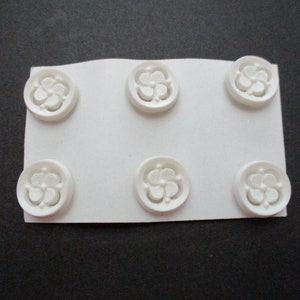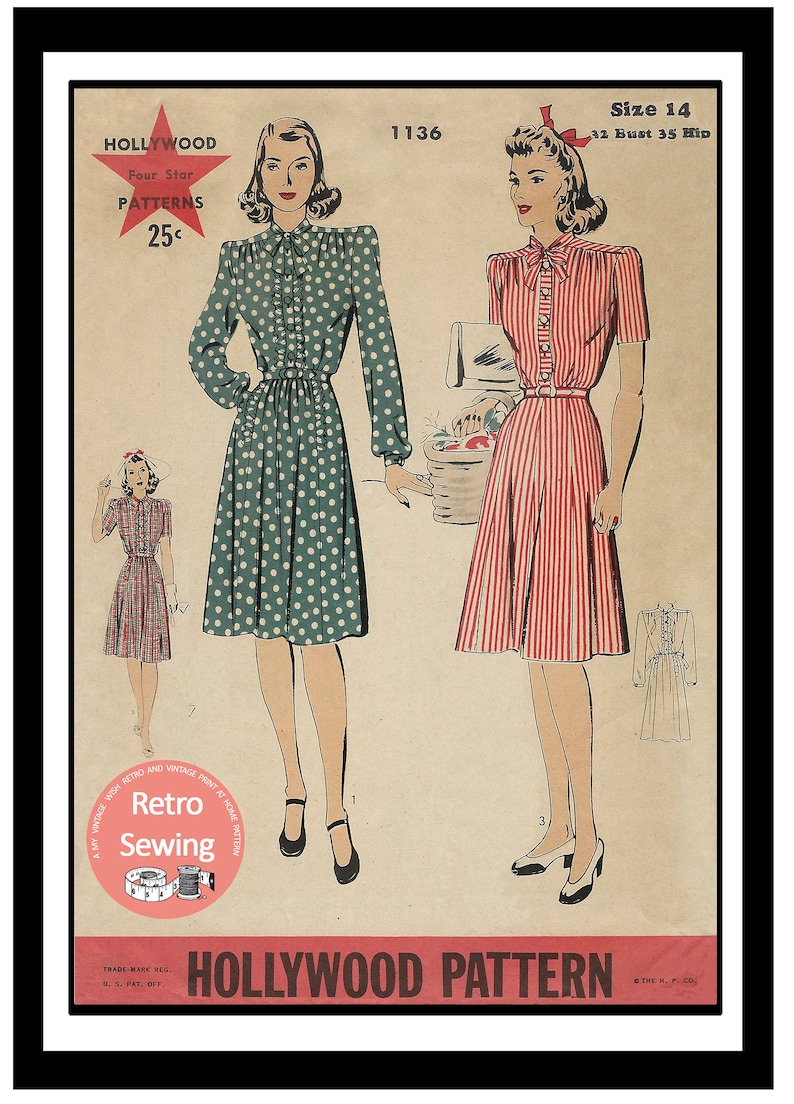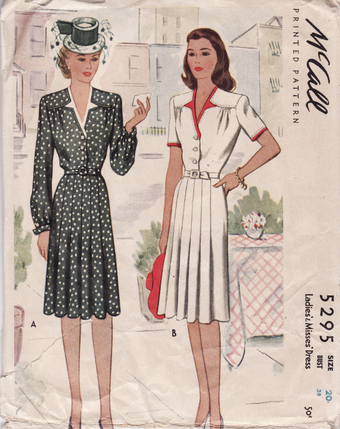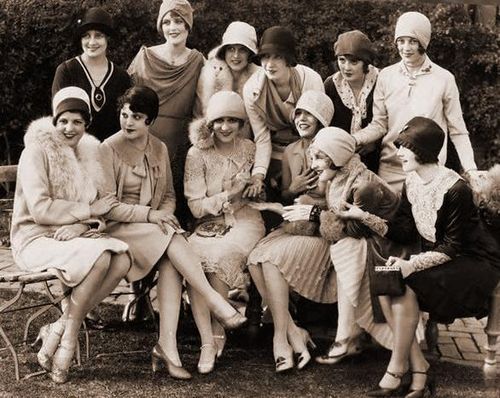 |
| Simplicity 4731; ©1954; Misses' and Women's One-Piece Dress |
Pattern Description: A small shaped collar and cuffed sleeves style this softly tailored dress. The skirt side front has a yoke section forming a pocket. The upper edge of the pocket is shaped. The dress has a front button closing. View 1 fastens at the neck. Collar, cuffs of elbow-length sleeves and edge of skirt pocket are accented with top-stitching. View 2 is open at the neck, sleeves are short.
 |
| Here is a photo of the envelope that I was able to locate on Pinterest; mine, unfortunately, is long past its glory days and looks poorly. |
 |
| I combined View 1 and View 2 (View 2's open neck, and View 1's long sleeves). |
This dress has been 3 months in the making with on-and-off work. I was hoping to have finished this project before the end of 2019 but alas, this project had its issues.
 The Supplies
The Supplies:
- Pattern: Simplicity Printed Pattern 4731 Size 14 Bust 32" $0.10
- Fabric: 3.5 yards of Keepsake Calico, Greek Isle N5420 Quilt Fabric, purchased from JoAnn's. 43" 100% cotton, machine wash cool delicate. $17.47
- Buttons: 1960's Yellow Raindrop Buttons, 10 count, 15mm, purchased from brizelsupplies on Etsy. $10.24
- Thread: Coat 250 yd. in brown $3.99
- Interfacing
Total Cost: $31.80
The Process:
I purchased this vintage pattern, along with two others at the beginning of August 2019, all 3 priced at 10 cents each! Such a lucky find!
I knew going in that it would be a challenge, especially considering that it would be my first time using genuine vintage sewing patterns. It was rather exciting, not to mention nerve-wracking. The envelope was quite damaged and extremely brittle, and the pattern instructions were faded and falling apart. With this in mind, I went through the tedious process of carefully photo-copying the original instructions and tracing the original pieces onto tracing paper. If it means that this pattern and its contents can be passed on to future generations and that it lasts another 60 years, then it will have been worth it.

Because the envelope was so damaged the size listed was almost indistinguishable, but thanks to some detective work I learned it was a size 14, one size smaller than my measurements. Fair enough I thought, I can just resize the pattern, but after taking the waist measurements of the skirt pattern pieces I was convinced that it would fit. I was right...to an extent. The skirt did indeed fit. The bodice, not so much. After completing the bodice I discovered that the skirt had to be gathered to fit. Whoops! I couldn't just recut the pieces, let alone recut a single piece as I used almost every scrap of fabric. After some deliberating for several weeks, I decided to remove 2 of the 4 pleats on the front bodice, which gave me the 2 additional inches I needed. So no skirt gathering! 😀
When it came to cutting out the fabric I employed the use of pattern weights or rather varying objects (stapler, bean-filled pincushions, water spritzer, etc.) instead of sewing pins. This seemed to quicken the process, made my cuts more accurate and left less damage to the pattern paper. Definitely a technique I'll use again in the future, though perhaps with real pattern weights. I also used tailor tacks and thread tracing techniques instead of water-soluble fabric markers.

I combined View 1 and View 2 (View 2's open neck, and View 1's long sleeves).
I used almost all 250 yards of the thread I bought for this project due to testing out the functions of my new sewing machine that I received from my family from my birthday. That, and all the basting I did and redid. Whoops!
Instead of just simply lining up pattern pieces to the grain lines, I also cut out the fabric so that when assembled, the lines of polka dots would line up continuously along the skirt and bodice. The semi-striped fabric made it easier to cut out and assemble the pieces and was well worth the extra work!
The pattern instructions were very difficult for me to understand. I'm unsure whether it has to do with my knowledge, general sewing instruction confusion, or the vintage terminology. Perhaps all of the above. The instructions served little use to me and I abandoned them after the 4th step. The sewing illustrations were far easier to understand.

I even took the time to buy and put in interfacing, now that's commitment!
Thankfully I didn't have to make bound buttonholes as my new sewing machine has buttonhole capabilities. So what might have taken me 2+hours probably only took me half an hour despite all my mistakes.
The dress very much resembled a robe prior to hemming. Which might be good for a future robe, but not really what I was going for. Trimming a good 2.5" from the hem and folding the remaining 1.5" (if my memory serves me well) made it the appropriate length for a mid-calf length dress. This is where the lined up polka dots came into play again. It made it extremely easy when it came to cutting the hem and sewing those last few stitches.
The only finishing touches I still need to do is to add a snap to the waist where it tends to gap, and embroider a label with my name, the year, pattern name, and pattern #, and sew onto the bottom of the neck facing.
.
Review and Conclusion:
My only regret with this dress, or rather two was not for taking more time when it came to finishing the seam connecting the sleeve to the cuffed sleeve. Despite stitches tacking it to the inside of the sleeve, it can sometimes come untucked. The other being the neck facing. The neck facing was either not addressed in the pattern instructions or I couldn't decipher it because when worn the neck facing tends to want to stick out the top because of excess fabric. This can likely be remedied by simply placing one or two well-placed darts with the dark facing headwords.

What I love:
- Pockets!
- The longer sleeve option
- A-line shape
What I hate (okay, maybe not hate):
- The sleeve cuffs aren't my favorite as they tend to jut out; I'd likely skip this step if I made this dress again
What I would change:
- Make deeper pockets
- Resize the bodice waist so I can include all the pleats
- Topstitch the collar (somehow skipped that step)
Fin! And here are some additional photos of the finished dress.













































